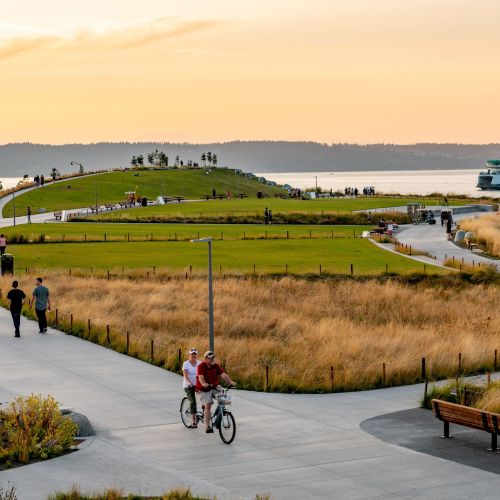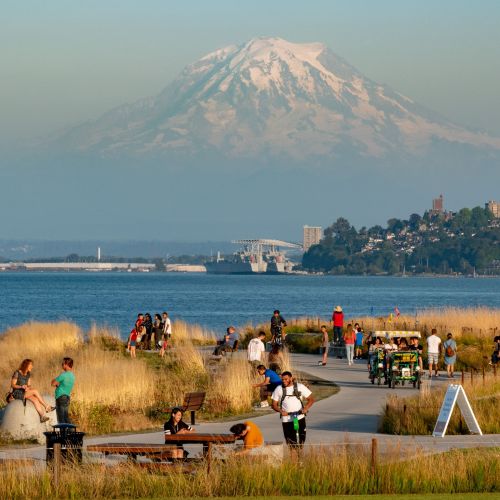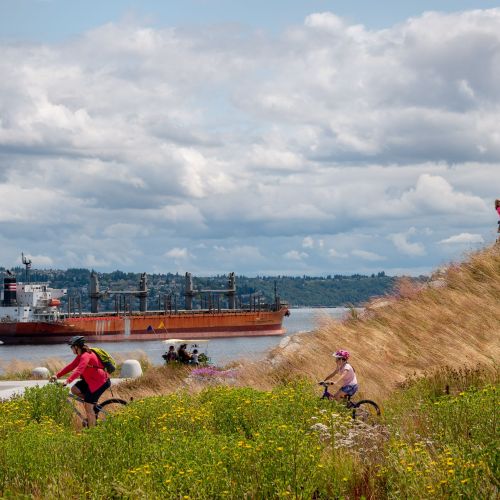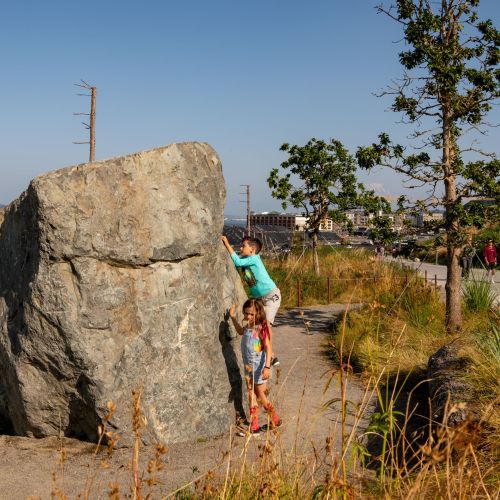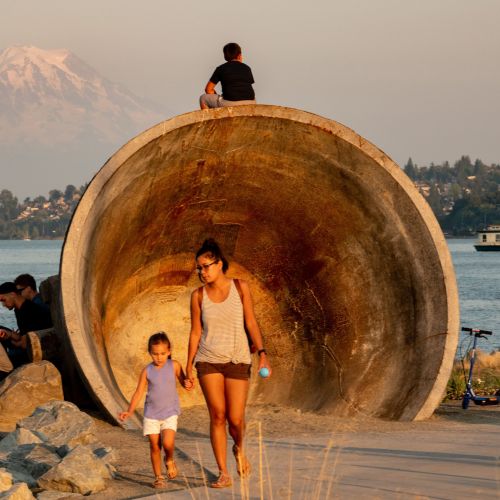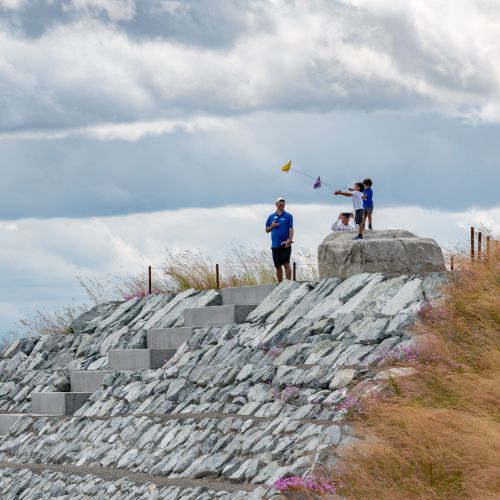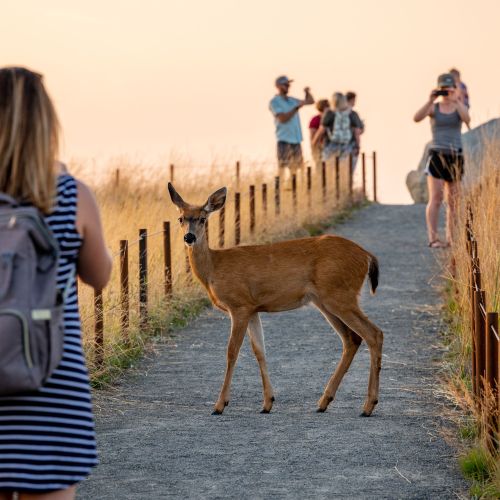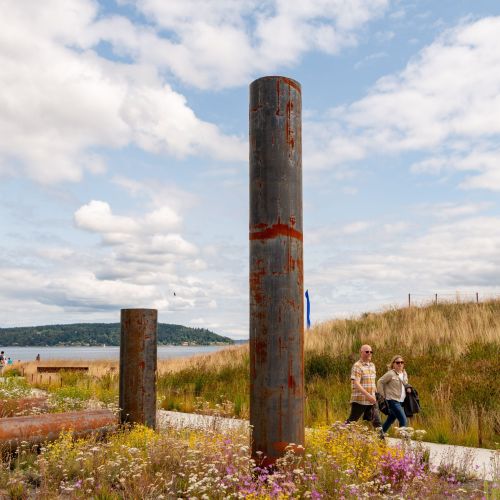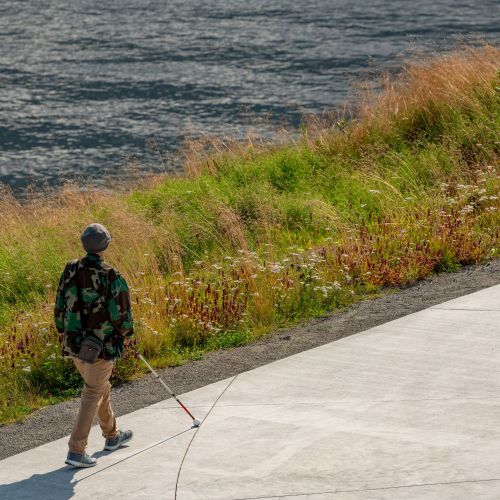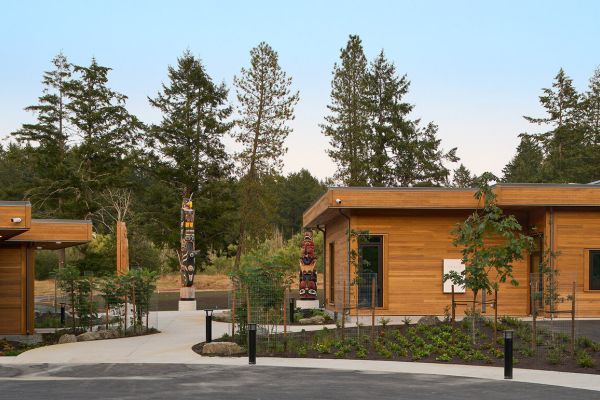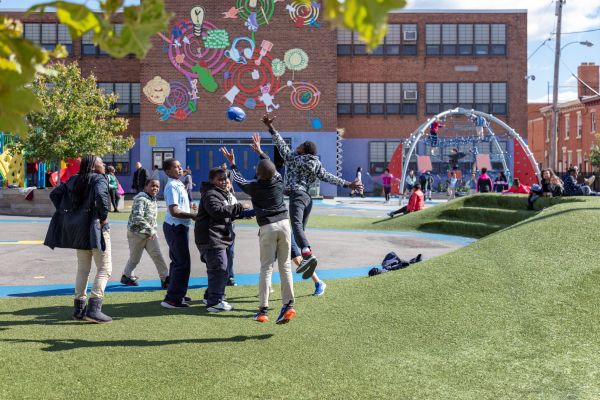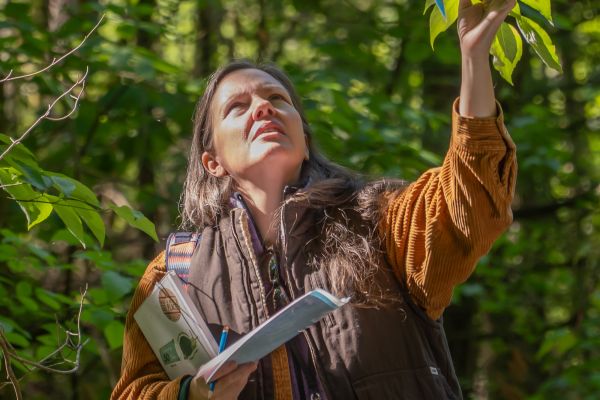About
Located on the waterfront at Tacoma, Washington, Dune Peninsula at Point Defiance Park is a multi-layered recreational park that brings together the site’s industrial past and the region’s natural history. The 11-acre peninsula, a former Superfund site due to the dumping of toxic slag, was transformed into a park that offers gathering areas, scenic vistas, art installations, educational exhibits, an event venue, a network of paths, and more, all in an area that was previously inaccessible to the public.
Project Details
Description
The Dune Peninsula at Point Defiance Park in Tacoma, Washington, offers visitors of all ages multiple opportunities for recreation. The waterfront locale — an EPA Superfund site that was previously inaccessible to the public — boasts panoramic vistas from which to observe marine habitat and watch whales, seals, orcas, and eagles. There are abundant paths for strolling, cycling, and jogging, as well as art installations, play features, and gathering areas, as well as an outdoor event venue. An extensive planting filled with native Puget Sound prairie plants helps connect visitors to the area’s natural history and offers educational opportunities to support environmental awareness and conservation.
Located on the footprint of a former American Smelting & Refining Company (ASARCO) smelter, the park is built atop an 11-acre peninsula created when, over the course of almost 100 years, the company dumped huge amounts of slag contaminated with toxic heavy metals into the Puget Sound. The culmination of decades-long efforts to remediate the polluted site, the park demonstrates the value of habitat restoration and is an intergenerational recreational space that both acknowledges the area’s industrial past and celebrates the region’s natural history and beauty.
Project Goals
- Contain contaminated soil and remediate a toxic Superfund site by transforming it into a public destination park.
- Make publicly accessible for the first time a waterfront vantage point with uniquely beautiful vistas and the opportunity to observe marine habitat with and watch whales, orcas, and seal in an adjacent habitat basin.
- Create healthy, biodiverse nearshore and terrestrial habitat for local plants and wildlife by reducing pollutants entering the water and reintroducing Puget Sound prairie, an endangered landscape with only 3% of its original range remaining.
- Showcase a prairie landscape typology and encourage replication of planting approaches throughout district parks and interstitial sites to provide habitat connectivity within Tacoma’s Metro Parks, and serve as an example for future projects aiming to reclaim industrial sites as recreational destinations that promote rich, productive habitat and varied ecologies.
- Positively impact mental and physical well-being, social engagement, and access for visitors by connecting the park and waterfront to the rest of the city via a universally accessible multi-modal trail, filling a critical missing link in the long-planned Downtown-to-Defiance multi-modal trail, and offering new intergenerational recreational opportunities and meaningful engagement with nature.
- Offer inclusive opportunities for all ages and abilities to engage in discovery and play through wide accessible paths, ample seating, interactive art, and additional design elements with flexible uses.
- Provide educational opportunities for visitors that support environmental awareness, conservation, and approaches to low-maintenance landscapes while demonstrating to the Tacoma Parks Department that people respond positively to parks with native habitat.
- Connect visitors with the site’s “spirit of place” by expressing through landscape, art, and word a narrative that reflects the complex identity of Tacoma, its aspirations for the future, and the tension between the site’s productive industrial past and its rich natural history.
- Catalyze the local economy and encourage new development by providing a desirable public amenity through the remediation of an industrial-era environmental hazard that has been unjustly burdening the nearby, largely working-class and minority community for years, through contamination of air, soil, and water.
- Show sensitivity to the maintenance limitations of small parks departments while providing a greater ecological benefit than typical monoculture landscaping.
Reprinted from the original LAF LPS case study.
Social Benefits
- Promotes physical activity, with 94% of 578 surveyed visitors reporting engaging in at least 1 of 12 different physically active uses in the park.
- Facilitates a restorative nature experience, with 26% of 578 surveyed visitors using language indicative of a restorative experience when describing experiences in the park. Additionally, 28% selected “tranquil” when asked how they feel in the park, 30% reported restorative uses, and 82% reported engaging in nature-connected uses.
- Supports positive emotional affect (happiness) in park visitors, with 94% of 578 surveyed visitors reporting a positive emotion when asked how they feel when they are in the park. 97% of 266 surveyed visitors responded “yes” when asked if spending time in the park made them feel happier. The park also scores a high-performing 82% on a happiness index assessment tool.
- Offers the potential for meaningful interactions with nature, scoring 90 out of 100 using an evaluation tool for human-nature interaction.
Reprinted from the original LAF LPS case study.
Contact markb@siteworkshop.net beckyh@siteworkshop.net Design Firm – Site Workshop Dune Peninsula at Point Defiance Park
Key Contributors
Landscape Architect and Prime Consultant
Site Workshop
Contractors:
Artists: Adam Kuby and Nicole Rathburn
Remedial Action Engineering: Jacobs Engineering Group
Civil Engineering and Shoreline Permitting: Parametrix
Bridge Engineering: COWI
Architecture: BOEarchitects
Geotechnical Engineering and Environmental: GeoEngineers
Electrical Engineering: Cross Engineers
Cost Estimating: Project Delivery Analysts
Prairie Consultation and Primary Seed Source, Consulting Resource ISWP, Irrigation Design: Center for Natural Lands Management
Soil Science: Rozewood Environmental Services
Environmental Graphics: Michael Courtney Design
Funders & Supporters
Funding sources (including those for the work needed to remediate and prepare the site) include settlement funds from the bankruptcy of the ASARCO smelter plant, EPA, Washington Department of Ecology, Washington State Recreation and Conservation Office, and a 2014 Metro Parks voter-approved bond, among others. See More
Total Cost
$25 million
Amenities & Services
Outdoor
- 16-ft-wide main pathway provides a universally accessible multi-use trail connection
- 4-ft-wide and 8-ft-wide loop paths
- 5 acres of native prairie habitat
- site-responsive public art
- narrative signage and storytelling elements
- accessible picnic pavilion
- precast concrete “kettles,” seat steps, a zig-zag mow strip, and sand-lens walls
- amphitheater and concrete stage supporting multi-use
- 270-degree vistas of the Puget Sound, ferries, Vashon Island, the Olympic and Cascade ranges, and the iconic Mount Rainier
Awards
National American Public Works Association (APWA) Project of the Year, Historical Restoration/Preservation, 2020
ASLA Washington Chapter Award of Honor, 2019
ACEC Engineering Excellence Awards, Silver - Successful Fulfillment of Client/Owner Needs, 2019
GRAY Awards Landscape category winner, 2019
